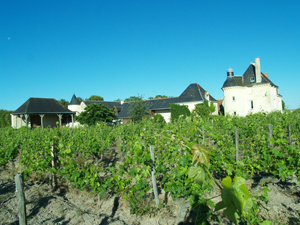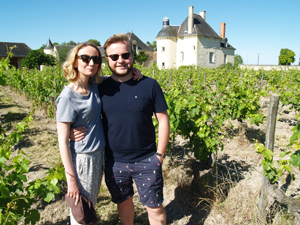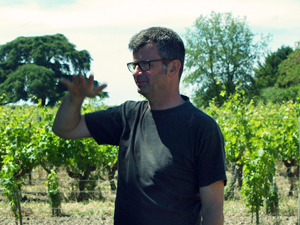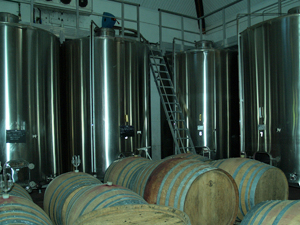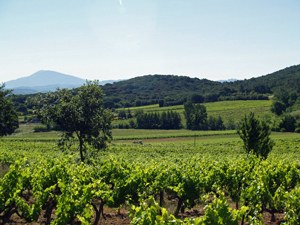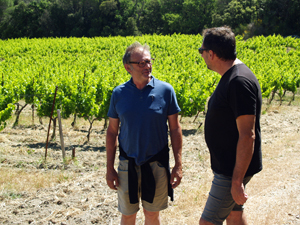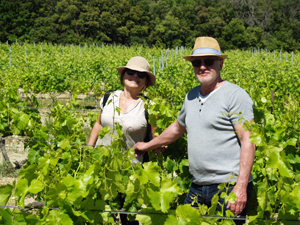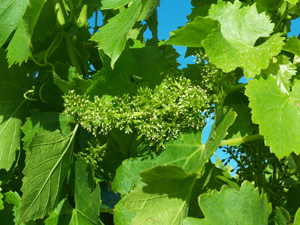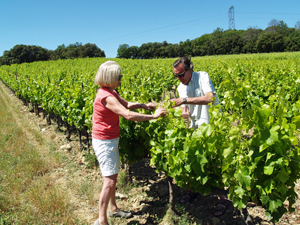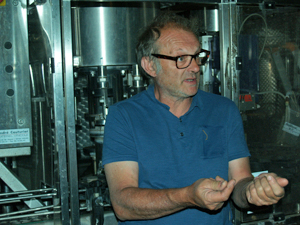The beginning of summer is a hectic time in the vineyard. Everything grows quickly and the winemaker has lots of work to do to keep everything under control and safeguard the quality of the future harvest as we were to find out during the
Gourmet Odyssey Discovery Experience Day at Château de la Bonnelière in the Loire Valley.
We started the day in Clos de la Bonnelière vineyard, next to the château. This is where our adopted vines are located, and we took a few minutes to find our vines, encourage them to produce a good harvest, and immortalise the moment with a few photos!
The winemaker, Marc Plouzeau, then explained all of the work that has been carried out in the vineyard so far this year, and in particular the vital task of pruning, so important in controlling the yield and improving the potential quality of the grapes.
The wet end to spring, followed by the warmth and sun of the past couple of weeks has meant that the vegetation has thrived and everything is growing really quickly. There is way more than enough to keep the winemaker busy, and so Marc was very welcome of our help for the day! He had set aside three different jobs for us to do.
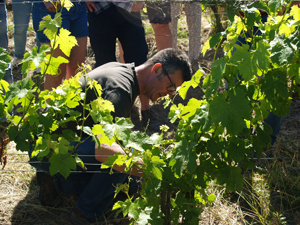
At this time of the year, the vines can grow more than 10 centimetres in a week. To protect the branches and future grapes, they need to be trained behind the training wires. This helps the vine support the weight of the branches, leaves, and future grapes, and keeps them out of the way of the tractor when it drives up and down the rows. First we had to raise the training wire on each side of the row, being careful not damage the floral caps of the vine flowers, and then we clipped the wires together. Finally we ensured that all of the branches were contained between the wires and as evenly spaced as possible to help improve the air flow around the leaves, something that is important to help the foliage dry more quickly following any rain, thus reducing the risk of disease.
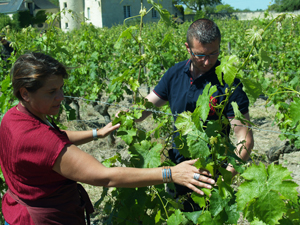
Despite the best efforts to prune the vines, there are always unwanted shoots that grow, either as double buds or from low down on the vine trunk. These shoots drain energy from the vines to the detriment of the quality of the grapes. By hand or with the help of a small spade, we removed any shoots that grew from the trunk. Marc also explained the way that vines are grafted onto root stocks that are resistant to phyloxera, and showed us the difference in the shoots that grow from the grafted vine or directly from the root, shoots that are known as Americans in reference to the origin of the roots.
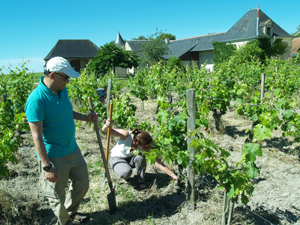
It’s not just the vines that are growing quickly. The grass and wild flowers are also thriving. The tractor had recently been put to work in the vineyard, lightly ploughing every other row to remove the grass and flowers. The unploughed rows had been mowed to keep the grass short and stop fungi from spreading to the vines. When ploughing, the tractor carries a special mechanical plough that does a fairly good job of ploughing around the vine stocks. It however struggles if the gap between two vines or between a vine and a training post is too small. In such instances, the only way to remove the grass and flowers is by hand with the help of a hoe. This was the third task Marc had reserved for us, and so hoe in hand, we got stuck in!
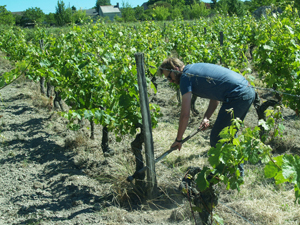
After our busy morning, we had earned our aperitif! Marc served us a nice fresh glass of “Perle Sauvage”, his naturally sparkling wine made from Chenin Blanc grapes, accompanied by local rillettes, and homemade goats’ cheese cake and gougères. We continued the tasting of wine over lunch, the crisp 2018 Touraine Sauvignon “Bonnelière” pairing well with the fish terrine starter. We then tasted the reds with the Tagine main course, cheese and desert, starting with the fruity 2018 Chinon “La Roche”, then the more complex 2017 Chinon “Clos de la Bonnelière”, the wine chosen for the Gourmet Odyssey Wine Experience, and finishing with the full-bodied 2016 Chinon “Chapelle”.
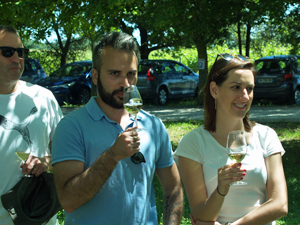
In the afternoon, we went for a short walk through the vineyards to a plot that Marc had recently planted. He explained how the vines are planted and the implications on production quantities involved. Before planting a new plot, another crop is planted to replenish the soil with lost nutrients. The new vines won’t produce any grapes for making wine in the first three years, followed by several years of low quality grapes. Replanting is something that it takes time to reap the rewards from!
Marc also took time to explain how the vines are cared for organically and the implications that it entails.
We ended the day in the cool of the vinification hall. Here Marc gave us an introduction to what happens when the grapes are received at harvest time, and how the juice is turned into wine. We’ll be spending much more time here during the Harvest and Vinification Experience Days.
Many thanks to all for a great day. We look forward to coming back for the harvest at the end of September or beginning of October.
Find out more about how you too can adopt vines and get involved in making your own bottles of personalised organic wine.
